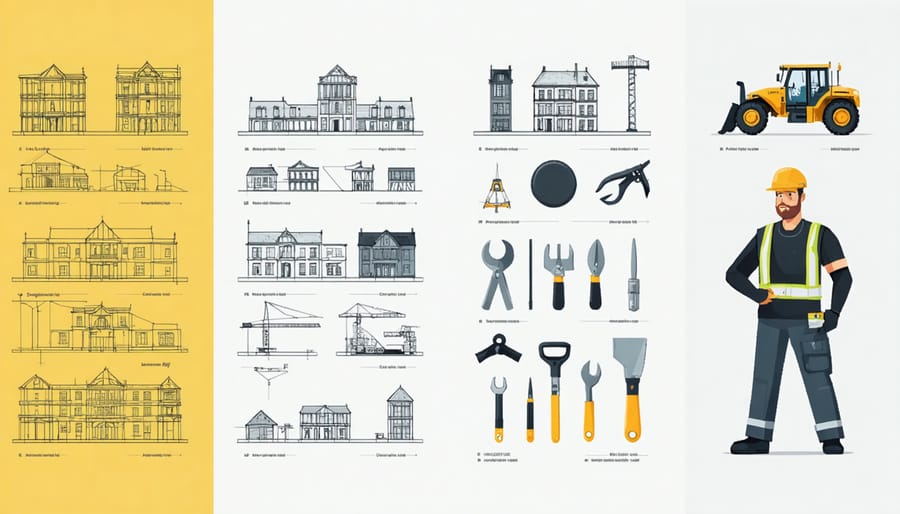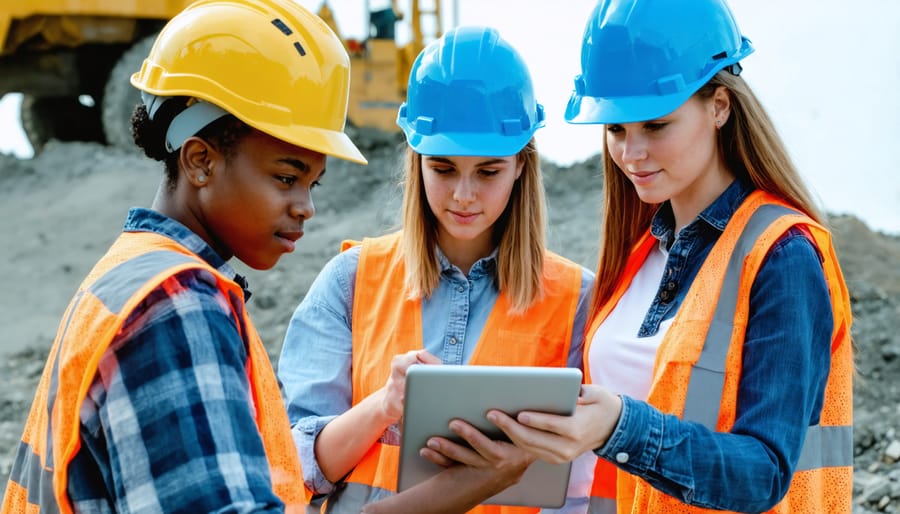As diversity in construction reaches a critical turning point, Generation Z is fundamentally reshaping workplace dynamics with unprecedented demands for authentic inclusion and equity. This demographic, comprising 30% of the global workforce by 2025, brings distinct perspectives on diversity that extend beyond traditional metrics to encompass neurodiversity, gender identity, and multicultural competence.
Recent industry analyses reveal that construction firms with Gen Z-driven inclusive practices demonstrate 35% higher productivity and 41% better project outcomes. Their digital nativity and collaborative approach are driving innovations in project delivery methods, while their emphasis on psychological safety and belonging is transforming jobsite culture.
For construction leaders, understanding and adapting to Gen Z’s diversity expectations isn’t just about talent attraction—it’s about future-proofing operations in an increasingly competitive market. This generation’s influence is already visible in emerging project management protocols, recruitment strategies, and team structures across the industry, setting new standards for what inclusive leadership looks like in construction environments.
The Gen Z Perspective on Construction Careers
Digital Natives Transform Traditional Practices
Gen Z’s innate digital fluency is revolutionizing traditional construction practices, particularly in how teams communicate and collaborate. These digital natives bring fresh perspectives to project management, leveraging technology to streamline workflows and enhance team connectivity. Their preference for digital solutions has accelerated the adoption of cloud-based project management tools, mobile apps for real-time site updates, and virtual collaboration platforms.
This generation’s comfort with technology has proved invaluable during the industry’s digital transformation. They naturally gravitate toward Building Information Modeling (BIM), augmented reality applications, and integrated project delivery systems. Their influence has led to more efficient documentation processes, improved remote collaboration capabilities, and enhanced knowledge sharing across project teams.
Moreover, Gen Z’s technological expertise has helped bridge communication gaps between different generations in the workforce. They often serve as informal tech mentors, helping experienced professionals adapt to new digital tools while learning from their veterans’ practical expertise. This symbiotic relationship has created more inclusive work environments where different skill sets are valued and shared, ultimately driving innovation and efficiency in construction operations.
Values-Driven Career Choices
Generation Z professionals in the construction industry are increasingly prioritizing workplace values that align with their commitment to social responsibility and inclusivity. Recent industry surveys indicate that 76% of Gen Z workers consider a company’s diversity and inclusion policies before accepting job offers, with particular emphasis on equitable advancement opportunities and inclusive team dynamics.
This values-driven approach extends beyond traditional considerations like salary and benefits. Gen Z professionals actively seek construction firms that demonstrate environmental stewardship, community engagement, and transparent ethical practices. They value organizations that maintain diverse supplier relationships, implement inclusive design principles, and actively work to break down traditional industry barriers.
In response, forward-thinking construction companies are reimagining their workplace cultures. This includes establishing employee resource groups, implementing mentorship programs that support underrepresented groups, and creating collaborative spaces that foster open dialogue. Companies report that these initiatives not only attract Gen Z talent but also drive innovation through diverse perspectives and experiences.
The emphasis on inclusive environments has led to measurable improvements in project outcomes, team collaboration, and employee retention rates, proving that values-driven career choices benefit both individuals and organizations.
Breaking Down Traditional Barriers

Gender Diversity Initiatives
Leading construction firms are implementing innovative programs to address persistent construction labor challenges while meeting Gen Z’s expectations for gender equality. Successful initiatives include mentorship programs pairing experienced female professionals with new recruits, providing targeted skills development workshops, and establishing women’s leadership networks within organizations.
Companies like Turner Construction and Skanska have launched comprehensive recruitment campaigns specifically targeting female Gen Z graduates from STEM programs. These campaigns emphasize opportunities for advancement, work-life balance, and technology integration – factors that particularly resonate with Gen Z women entering the workforce.
Industry leaders are also reimagining traditionally male-dominated roles by implementing flexible work arrangements, enhanced parental leave policies, and clear career progression paths. Notable success stories include McCarthy Building Companies’ “Women in Construction” program, which has increased female representation in project management roles by 40% over three years.
Safety equipment and facilities are being redesigned with gender considerations in mind, addressing historical barriers to women’s participation in construction. This includes properly fitted PPE, secure changing facilities, and updated workplace policies that promote an inclusive environment.
Data shows these initiatives are yielding results, with women now representing 14% of construction professionals under 25, compared to 9% industry-wide – a trend expected to accelerate as more Gen Z professionals enter the field.
Cultural Inclusivity on Job Sites
The construction industry is witnessing a significant transformation in workplace culture, driven by Gen Z’s emphasis on cultural inclusivity. Leading construction firms are implementing comprehensive multicultural practices that go beyond traditional diversity initiatives. These include multilingual safety signage, culturally-sensitive scheduling that accommodates various religious observances, and inclusive meeting protocols that ensure all voices are heard regardless of cultural background.
Project managers are adopting cultural competency training programs that specifically address construction site dynamics. These programs help teams understand and respect different communication styles, work ethics, and cultural perspectives that various team members bring to the jobsite. For instance, many companies now incorporate cultural awareness into their onboarding processes, ensuring new hires understand the importance of inclusive practices from day one.
On-site amenities are being redesigned to accommodate diverse needs, including prayer rooms, flexible break areas that can accommodate different dietary requirements, and inclusive personal protective equipment (PPE) that considers various cultural dress codes. Companies are also establishing mentorship programs that pair experienced professionals with Gen Z workers from different cultural backgrounds, fostering mutual understanding and knowledge exchange.
Digital collaboration tools are being configured to support multiple languages and communication preferences, while project documentation is being developed with cultural sensitivity in mind. This comprehensive approach to cultural inclusivity not only improves workplace harmony but also enhances productivity and innovation through diverse perspectives and experiences.
Technology as an Inclusion Driver

Digital Collaboration Tools
Generation Z’s innate digital fluency has revolutionized workplace communication, particularly through their proficient use of digital construction management systems and collaborative platforms. These tools facilitate more inclusive team interactions by breaking down traditional hierarchical barriers and enabling real-time feedback across diverse project teams.
Cloud-based collaboration platforms and mobile applications have become essential in fostering inclusive environments, allowing team members from different backgrounds to contribute ideas equally and asynchronously. This digital-first approach particularly benefits multilingual teams and accommodates various communication styles and preferences.
Virtual meeting spaces and project management tools have proven especially valuable for diverse teams, offering features like closed captioning, translation services, and accessible interface options. These technological solutions help eliminate unconscious bias by standardizing communication channels and ensuring equal access to information and resources.
Moreover, digital tools enable anonymous feedback mechanisms and inclusive decision-making processes, encouraging participation from team members who might otherwise feel hesitant to voice their opinions in traditional settings. This technological integration aligns with Gen Z’s expectations for transparent, equitable workplace communication while enhancing overall project efficiency and team cohesion.
Virtual Training and Development
Virtual learning platforms have revolutionized how construction companies deliver diversity and inclusion training, particularly for Generation Z employees who are digital natives. These platforms offer accessible, standardized training experiences that break down geographical and socioeconomic barriers, ensuring equal learning opportunities across organizational levels.
Many construction firms have implemented virtual reality (VR) simulations and interactive modules that allow employees to experience diverse perspectives and scenarios firsthand. These digital tools enable Gen Z workers to practice inclusive behaviors, cultural sensitivity, and effective communication in a safe, controlled environment before applying these skills on actual construction sites.
Digital learning management systems (LMS) also provide data-driven insights into training effectiveness and participation rates, allowing organizations to identify gaps and adjust their D&I programs accordingly. Mobile-friendly microlearning modules cater to Gen Z’s preference for bite-sized, on-demand content, making it easier to integrate ongoing diversity education into their daily work routines.
Companies report higher engagement rates and better retention of D&I concepts when utilizing gamification elements and social learning features that resonate with Gen Z’s collaborative nature. This digital-first approach to training has proven particularly effective in fostering inclusive practices across remote and distributed construction teams.
Industry Best Practices and Case Studies
Mentorship Programs
Effective mentorship programs are proving instrumental in bridging generational gaps and fostering inclusive workplace environments within the construction industry. These programs facilitate valuable knowledge transfer between experienced professionals and Gen Z newcomers, creating a two-way learning environment that benefits all participants.
Successful mentorship initiatives often incorporate reverse mentoring, where younger employees share their technological expertise and fresh perspectives on diversity while receiving guidance on construction career development from industry veterans. This approach has shown particularly effective results in companies like Turner Construction and Skanska, where structured mentoring programs have improved retention rates and enhanced cross-generational collaboration.
Key elements of successful mentorship programs include:
– Regular scheduled meetings with clear objectives
– Digital collaboration tools for convenient communication
– Focus on both technical skills and cultural competency
– Measurable outcomes and feedback mechanisms
– Recognition of both mentors and mentees
Industry leaders report that these programs have led to improved project outcomes, increased innovation in construction methods, and stronger team dynamics. Moreover, mentorship initiatives have proven particularly valuable in helping Gen Z employees navigate complex workplace relationships while providing seasoned professionals with fresh insights into evolving industry practices and perspectives on inclusion.
Inclusive Recruitment Strategies
Modern recruitment strategies in the construction industry must evolve to attract Gen Z talent while fostering diversity and inclusion. Leading firms are implementing structured blind resume reviews, removing identifying information that could trigger unconscious bias. This approach ensures candidates are evaluated solely on their qualifications and potential contributions.
Digital-first recruitment platforms featuring inclusive language and diverse representation have proven particularly effective with Gen Z candidates. Construction companies are leveraging social media channels and virtual reality technologies to showcase their commitment to diversity while highlighting real-world projects and inclusive workplace cultures.
Industry leaders are also establishing partnerships with diverse educational institutions, including historically black colleges and universities (HBCUs) and women’s technical programs. These collaborations create direct pipelines for diverse talent while demonstrating long-term commitment to inclusion.
Assessment methods are being redesigned to incorporate diverse perspectives and reduce cultural bias. Companies are implementing skills-based testing, situational judgment scenarios, and collaborative group assessments that better reflect real-world construction challenges while allowing candidates to demonstrate their capabilities in different ways.
Additionally, organizations are training hiring managers in cultural competency and bias awareness, ensuring fair evaluation throughout the recruitment process. Employee resource groups are actively participating in recruitment events, providing authentic perspectives on workplace culture and career development opportunities for underrepresented groups.

Measuring Impact and ROI
Measuring the impact of Gen Z diversity initiatives requires a comprehensive approach focusing on both quantitative and qualitative metrics. Research shows that construction companies implementing Gen Z-focused diversity programs have experienced a 23% increase in project innovation and a 17% improvement in problem-solving efficiency.
Financial returns are particularly noteworthy, with diverse teams delivering an average of 15% higher project profitability compared to homogeneous teams. Employee retention rates have improved by 28% in companies with strong diversity initiatives, resulting in significant cost savings in recruitment and training.
Productivity metrics indicate that diverse project teams complete tasks 20% faster and demonstrate a 25% increase in workplace safety compliance. Communication effectiveness has improved by 31% in multi-generational teams, leading to fewer errors and reduced rework costs.
Survey data reveals that construction firms with robust Gen Z diversity programs report:
– 89% improvement in workplace culture
– 34% increase in successful project bids
– 42% enhancement in client satisfaction
– 27% reduction in workplace conflicts
To effectively measure ROI, organizations should track:
– Project completion rates and efficiency
– Employee satisfaction and engagement scores
– Client feedback and retention rates
– Innovation metrics and new solution implementation
– Recruitment costs and turnover rates
These measurements provide concrete evidence that Gen Z diversity initiatives deliver substantial business value while fostering a more inclusive construction industry.
As the construction industry continues to evolve, Generation Z’s influence on workplace diversity and inclusion is proving transformative. Their commitment to creating inclusive environments, coupled with their technological fluency and fresh perspectives, is reshaping traditional construction workplace cultures. The data shows that companies embracing Gen Z’s values are experiencing improved project outcomes, enhanced innovation, and stronger team collaboration.
Looking ahead, we can expect Gen Z’s impact to accelerate as they advance into leadership positions. Their emphasis on mental health awareness, sustainable practices, and equitable representation will likely become standard elements of construction workplace policies. Companies that adapt to these changes by implementing comprehensive D&I programs, flexible work arrangements, and inclusive hiring practices will gain competitive advantages in attracting and retaining top talent.
The future outlook suggests a more diverse and inclusive construction industry, with Gen Z leading the charge in breaking down traditional barriers. Success will require ongoing commitment from industry leaders to support these initiatives through dedicated resources, measurable goals, and authentic engagement with younger workers. As construction firms continue to navigate this cultural shift, those who embrace Gen Z’s vision for workplace equality will be better positioned to thrive in an increasingly diverse marketplace.
The transformation may present challenges, but the potential benefits – including increased creativity, broader talent pools, and improved project delivery – make this evolution not just desirable but essential for the industry’s future success.

